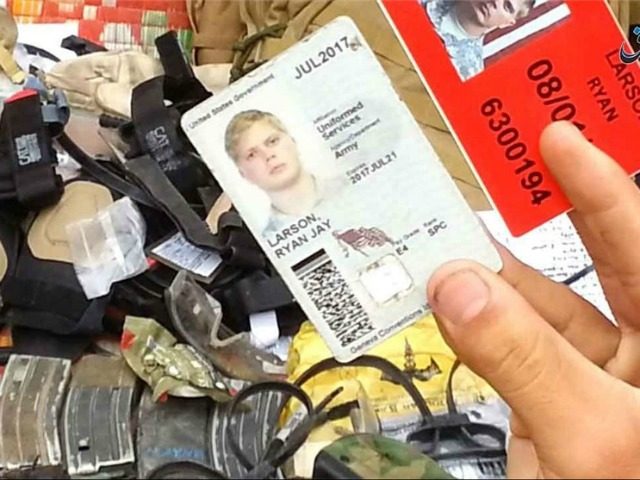Jihadists from the Islamic State (ISIS/ISIL) branch in Afghanistan have released several photos that purport to show the identification card of a U.S. soldier, along with weapons and other military equipment confiscated from American troops in eastern Afghanistan.
The claim comes as The Wall Street Journal (WSJ) reports that the ISIS offshoot, known as the Khorasan Province (IS-KP/ISIL-K), and the Taliban have agreed to stop fighting each other in eastern Afghanistan and have shifted their focus on combating U.S.-backed Afghan forces in that region.
Referring to the U.S. military equipment allegedly captured by ISIL-K, Reuters reports:
The photos, which came to light on Saturday, show an American portable rocket launcher, radio, grenades and other gear not commonly used by Afghan troops, as well as close up views of identification cards for a U.S. Army soldier, Specialist Ryan Larson.
The U.S. military command in Kabul denied any suggestion the soldier had been captured, saying he “has been accounted for and remains in a duty status within his unit.”
#ISIS 'Amaq posted photos of documents and gear of #American soldiers allegedly taken by ISIS fighters in #Nangarhar pic.twitter.com/UDat7qOFvX
— SITE Intel Group (@siteintelgroup) August 6, 2016
As part of a new offensive against ISIL-K in eastern Afghanistan’s Nangarhar province, U.S. special operations troops have been fighting alongside Afghan forces.
Nangarhar province, which sits along the Pakistan border, was identified as an ISIL-K stronghold soon after the group announced its presence in Afghanistan in January 2015, less than a month after U.S. President Barack Obama announced an end to the American combat mission in the country.
Gen. John Nicholson, the top commander of U.S. and NATO forces in Afghanistan, told reporters late last month that five American troops have already been wounded in the offensive against ISIL-K in Nangarhar.
“SPC Larson was attached to a unit conducting a partnered (operation) with Afghan Forces,” Cmdr. Ron Flesvig, a spokesman for the U.S. military in Afghanistan reportedly said in an emailed statement on Sunday, referring to the military I.D. allegedly seized by ISIL-K. “The soldier’s I.D. and some of the equipment were left behind after the (operation). The loss of personal identification is unfortunate.”
“The website that published the photos speculated that the equipment and weapons were left behind during that engagement, but Flesvig said American officials are still trying to determine exactly when and how it was lost,” notes Reuters.
WSJ reports that the regional ceasefire between ISIL-K and the Taliban comes after more than a year of turf battles.
Both terrorist groups officially declared jihad on each other in mid April of last year.
WSJ notes:
Until several months ago, Islamic State fought bloody battles with local Taliban units over fighters and territory in several provinces.
The long-running Taliban insurgency has sought to stamp out its smaller rival, which only emerged in 2014. Afghan and U.S.-led coalition forces took advantage of the conflict, engaging the militants on multiple fronts to push them back and reclaim territory they held.
But recently, Afghan officials say, the two insurgencies have worked out local deals to stop fighting each other and turn their sights on the government. The upshot is that Islamic State has been able to focus on fighting U.S.-backed Afghan forces in Nangarhar province and shift north into Kunar province, establishing a new foothold in a longtime Taliban and former al Qaeda stronghold.
In late May 2015, the then-governor of northern Afghanistan’s Kunar province warned of an alliance between the two jihadi groups.
TOLO News reported:
Kunduz provincial governor Mohammad Omer Safi has said that Afghan insurgents are fighting alongside Daesh [ISIS] in the country’s besieged northern province.
….
Safi said that the Taliban in these areas have pledged allegiance to Daesh in an attempt to create a safe haven for insurgents being driven out of Pakistan’s northern Waziristan tribal region.
Gen. Nicholson appeared to downplay the alliance between the two jihadi groups, saying that “the cease-fire between the militant groups in Kunar didn’t reflect a broader agreement,” reports WSJ.
“There’s still a conflict even though they may have a local cease-fire in place,” said the top U.S. commander in Afghanistan. “There’s always been a live-and-let-live dimension to some of the social fabric.”
The Wall Street Journal points out:
For now, local officials are skeptical the cease-fire will grow into an actual battlefield alliance. For one thing, ideologies differ. The Taliban want foreign forces to leave Afghanistan and Shariah law to be established, while Islamic State wants to create a global caliphate. Neither wants to relinquish control to the other group.
Late last month, ISIL-K claimed responsibility for the deadliest attack in Kabul of the nearly 15-year-old Afghanistan war, killing 80 people and wounding another 231.

COMMENTS
Please let us know if you're having issues with commenting.